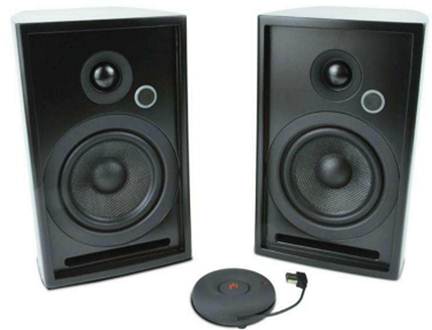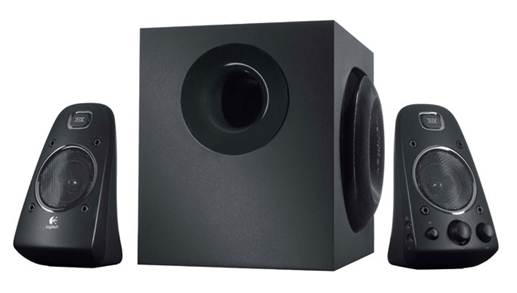Close enough for jazz
The performance of Aperion Audio's Zona
speakers is good enough for us to grant the company poetic license in labeling
these speakers "wireless." They'd need to be battery-powered in order
to be entirely free from wires, an impractical solution because those batteries
would need to be humongous to power the 20-watt Class D amplifier in each
cabinet.

Aperion Audio's Zona speakers
As it stands, each speaker requires a hefty
power brick plugged into a power outlet to function [the electrical cables are
quite long—17.5 feet—to reach distant outlets]. The wireless element comes in
the form of a small puck with a USB cable and a 1/8-inch stereo input. Plug the
puck into your PC’s USB port, and it becomes a USB audio device that takes the
computer's PCM audio output and streams it to wireless receivers built into the
speakers. The PC powers the puck's wireless transmitter. The Zona is also a
great solution for folks who'd like to deploy surround-sound speakers, but
can't stomach the idea of stringing speaker cable to the back of the room. In
this scenario, you'll connect your A/V receiver's analog pre-amp surround
channels to the puck's audio input, and plug its USB cable into the provided AC
adapter. Aperion provides all the cables you'll need.

Each 15-pound cabinet houses a 20-watt Class D amp driving a 1-inch
silk-dome tweeter and a 4.5-inch woven-fiberglass woofer
The wireless transmitter and receivers
operate on the 2.4GHz frequency band, but we didn't encounter any interference
issues even though we have one wireless router and two Wi-Fi access points
operating in the house we tested them in (and one of the APs was less than six
feet away from the Zona's transmitter]. According to Aperion, the system sends
an uncompressed bit stream with 16-bit resolution at a sampling rate of 48 kHz.
That's more than adequate for tracks ripped from CD, but you will lose some
fidelity when streaming 24-bit FLAC files or Blu-ray movie soundtracks. We also
detected a very small amount of background hiss in the absence of any other
audio signal, but only when we put our ear directly against the speaker's
grill. If those shortcomings bother you, stick with a wired solution.
Aperion claims the system is capable of
100-foot range, but they're probably not factoring in any walls obstructing the
signal path. In our experience, we were able to stream audio from the HTPC in
our room-within-a-room home theater to any other room in our 2,700-square-foot
house, but we encountered audible dropouts at the fringes when we blocked a
speaker with our body. Perhaps more importantly, we didn't detect any audible
lag when we set up the speakers as surround channels within our home theater.
Listening to Cara Dillon's rendition of the
Irish folk song "The Parting Glass,” from the Bowers & Wilkins'
release Live at the Grand Opera House (encoded in 24-bit FLAC at a 48kHz
sampling rate), it was easy to forget that the music was streaming over the
airwaves. The speakers delivered a solid performance with crisp highs and a fat
bottom end; and while the loss in fidelity from down-sampling was noticeable,
it wasn't particularly irksome. Given the choice, we'll always take the
no-com-promises wired solution. But if that's not an option for you, Aperion
Audio offers an excellent alternative in the Zona Wireless Speaker System.